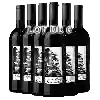
Château de Planques LivardieCuvee Livardie Monbazillac
This wine generally goes well with vegetarian, poultry or rich fish (salmon, tuna etc).
Food and wine pairings with Cuvee Livardie Monbazillac
Pairings that work perfectly with Cuvee Livardie Monbazillac
Original food and wine pairings with Cuvee Livardie Monbazillac
The Cuvee Livardie Monbazillac of Château de Planques Livardie matches generally quite well with dishes of rich fish (salmon, tuna etc), shellfish or sweet desserts such as recipes of salmon and goat cheese quiche, grilled lobster with tarragon cream sauce or rice with milk.
Details and technical informations about Château de Planques Livardie's Cuvee Livardie Monbazillac.
Discover the grape variety: Aubin
Aubin blanc is a grape variety that originated in France (Lorraine). It produces a variety of grape specially used for wine making. It is rare to find this grape to eat on our tables. This variety of grape is characterized by medium-sized bunches and small grapes. Aubin Blanc can be found in several vineyards: South West, Cognac, Bordeaux, Lorraine, Provence & Corsica, Rhone Valley, Languedoc & Roussillon.
Informations about the Château de Planques Livardie
The Château de Planques Livardie is one of of the world's greatest estates. It offers 2 wines for sale in the of Guyenne to come and discover on site or to buy online.
The wine region of Guyenne
45 kilometres east of Bordeaux, Blasimon is perched on a hillside overlooking the Gamage, a tributary of the Dordogne. Its hilly sites and its calm make it an ideal place to relax. A Village of medieval origin, its origin reflects the traditional organization of the bastides. The city conceals one of the Romanesque jewels of the Gironde, the Benedictine abbey of the X-XIII th centuries.
The wine region of South West
The South-West is a large territorial area of France, comprising the administrative regions of Aquitaine, Limousin and Midi-Pyrénées. However, as far as the French wine area is concerned, the South-West region is a little less clear-cut, as it excludes Bordeaux - a wine region so productive that it is de facto an area in its own right. The wines of the South West have a Long and eventful history. The local rivers play a key role, as they were the main trade routes to bring wines from traditional regions such as Cahors, Bergerac, Buzet and Gaillac to their markets.
The word of the wine: Closed
A flat wine that does not express its aromas.










